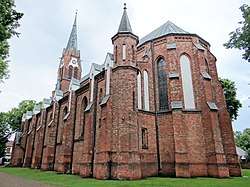Kałuszyn
Kałuszyn [kaˈwuʂɨn] is a small town in Masovian Voivodeship, Poland.
Kałuszyn | |
|---|---|
 Church of the Assumption of the Virgin Mary | |
 Coat of arms | |
 Kałuszyn | |
| Coordinates: 52°12′30″N 21°48′42″E | |
| Country | |
| Voivodeship | Masovian |
| County | Mińsk |
| Gmina | Kałuszyn |
| Town rights | 1718 |
| Government | |
| • Mayor | Arkadiusz Czyżewski |
| Area | |
| • Total | 12.29 km2 (4.75 sq mi) |
| Population (2006) | |
| • Total | 2,905 |
| • Density | 240/km2 (610/sq mi) |
| Time zone | UTC+1 (CET) |
| • Summer (DST) | UTC+2 (CEST) |
| Postal code | 05-310 |
| Area code(s) | +48 25 |
| Car plates | WM |
| Website | http://www.kaluszyn.pl |
History
From the early 17th century, Kaluszyn was predominantly Jewish. The community numbered 1,455 (80% of the total population) in 1827; 6,419 (76%) in 1897; 5,033 (82%) in 1921; 7,256 (82%) in 1931; and approximately 6,500 on the eve of the Holocaust. Economic branches included the manufacture of pottery, flour mills, prayer shawl weaving and the fur trade.[1]
After the Germans arrived in 1939, Jews were terrorized, robbed, and often kidnapped for forced labor. In 1940, a ghetto was established in Kaluszyn, and Jewish property was confiscated. Hundreds of Jews from surrounding communities were brought to the Kaluszyn ghetto, most with no possessions, money, or employment. Dozens, or perhaps hundreds, of Jews died in the ghetto of starvation and disease. In late summer 1942, many young Jews fled to the forests after hearing of the murders of the Jews of Warsaw and Minsk. In September, 1942, assisted by the Polish police, and possibly other auxiliaries, the Germans assembled the Jews at the market square. One Polish manager, Sheradzinsky, (the Berman plant) managed to free 30 of his employees from the assembly. Hundreds were murdered there and at the Jewish cemetery. The remaining Jews were taken by train to Treblinka where they were immediately murdered. A few managed to escape from the train. [2][3] [4]
References
- Jewish Virtual Library: Kalyszyn
- Megargee, Geoffrey (2012). Encyclopedia of Camps and Ghettos. Bloomington, Indiana: University of Indiana Press. p. Volume II 383-385. ISBN 978-0-253-35599-7.
- The Holocaust Quilt
- Three Minutes in Poland: Discovering a Lost World in a 1938 Family Film, Glenn Kurtz
External links
- Jewish Community in Kałuszyn on Virtual Shtetl
| Wikimedia Commons has media related to Kałuszyn. |